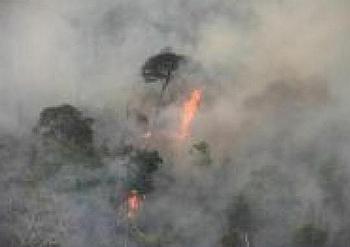
SAO LUIS, Maranhao, Brazil, November 1, 2015 (ENS) – A stubborn forest fire in the Brazilian Amazon is threatening to consume the forest home of one of the last remaining uncontacted tribes on Earth – the awá-Awá.
Despite the efforts of 200 volunteers from the Brazilian Institute of Environment and Renewable Natural Resources, IBAMA, the flames have devastated at least 35 percent of the 1,594 square mile area in Brazil’s northeastern state of Maranhao.

About 12,000 ethnic indigenous Guajajara and some 80 awá-Awá, also known as Awá-Guaja, call the area home.
Brazil’s state news outlet, Agencia Brasil, calls the Awá “indios who avoid contact with the white man and seek to live isolated in the woods.”
The trouble is, their rainforest home has been ablaze for weeks.
The fire in Arariboia has destroyed over 730 square miles of rainforest, more than 42 percent of the Arariboia Indigenous Territory, reports Toby Nicholas for Survival International.
“This designated territory is home to Awá people who have no contact with the outside world. Like all uncontacted peoples, they are extremely vulnerable to exposure to violence or disease inflicted by outsiders,” writes Nicholas.
About 250 firefighters are attempting to control the stubborn blaze on a fireline more than 100 kilometers (60 miles) long.
A brigade of tribal firefighters using machetes and sickles are working an average of 10 hours a day in temperatures above 40 degrees Celsius. Camped in tents in Guaruhu Village, many have been fighting the fire for more than 20 days.
A group of Guajajara men has been working alongside them to contain the blaze. Many Guajajara object to the illegal logging and forced contact with their neighbors, writes Nicholas.

Some of the firefighters are Indians from other states, such as Pedro Paulo Santos, a native of the neighboring state of Tocantins.
“From midday the outbreaks of fire reappear because the temperature is too high and vegetation too dry. The worst thing is the wind changes direction at all times, which generates new outbreaks,” Santos said.
Tribal chief Osmar Guajajara says the proximity of the Awá shows that they are scared and running away from the fire. A firefighting brigade operating near one village found Awá footprints and household items.
The chief blames the loggers for the fire, saying, “This fire came from the loggers that are considering a lot of people in this forest, touching fire, killing game, taking the wood, and destroying the land, ruining everything.”
“Today we have great sadness with our brothers Awá-Guaja at risk of death because this fire cuts off the route where they come to get water to drink. This fire is criminal,” cried the Indian leader.
According to Bruno de Lawrence, spokesperson for several uncontacted tribes, the situation shows how the government has failed to protect the State of Maranhão.
“All the isolated communities are threatened, and here the danger is greater,” he said. “We’re in the State of Maranhão, in 2015, and there are still Indians fleeing because of loggers.”
Survival International, the nonprofit global movement for tribal people’s rights, is calling on the Brazilian government to do more to put out the fire, protect the Awa’s land and save them from extinction.
“As if the Awá’s territory being ravaged by loggers wasn’t bad enough, now it’s being utterly devastated by fire. Yet government efforts to put out the fire have been shamefully half-hearted,” said Stephen Corry, director of Survival International, upon learning of the fire in Arariboia.
“Given how disastrous it is for the Awá, the authorities need to get the fire under control as a matter of urgency,” he demanded.
Last year, Survival’s global campaign helped to pressurize the Minister of Justice to send hundreds of agents to the Awá’s central territory to evict illegal loggers.
One man from a group called the Guajajara Guardians told Nicholas, “We are defending our territory, so that the uncontacted Awá can survive.”
The man asks that the uncontacted tribe be left in peace.
“We have managed to reduce the number of loggers on our land and we hope to force all of them out,” he said. “Otherwise, the Awá could be wiped out. We just want them to be able to live in peace.”
A doctor and two nurses from the Secretariat of Indigenous Health have now arrived to treat respiratory illness from smoke inhalation and cases of diarrhea due to consumption of water from contaminated sources. The fire has caused power failures in the village of Guaruhu, preventing the use of suction pumps to draw water from artesian wells.
For the first time, airdrops of water with fire retardant are scheduled from two aircraft loaned by the Brazian Air Force. The government also has ordered the Army Araribóia, 50th jungle infantry battalion, and the fire department to battle the blaze.
Last week, fire chief Marcio Yule, from the state of Mato Grosso do Sul, took over coordination of fire fighters in the area.
He is optimistic about the outcome of the flights for release of water, saying, “We believe that with the air combat and the arrival of more volunteers, we will have a decrease of at least 60 percent of the flames.”
But there are also reports of government firefighting teams being shot at by loggers.
Similar scenes are happening in other parts of Brazil where ancient tribes live in forests filled with hardwood trees valued for construction and furniture.
“Illegal logging in indigenous lands is happening all over Brazil,” said Greenpeace activist Danicley de Aguiar. “And as indigenous peoples take measures to stop it, retaliation – like violence or starting fires in the forest – grows.”
De Aguiar said, “Beyond putting out the fire, the main worry is guaranteeing the survival of these peoples.”
Copyright Environment News Service (ENS) 2015. All rights reserved.
© 2015, Environment News Service. All rights reserved. Content may be quoted only with proper attribution and a direct link to the original article. Full reproduction is prohibited.
